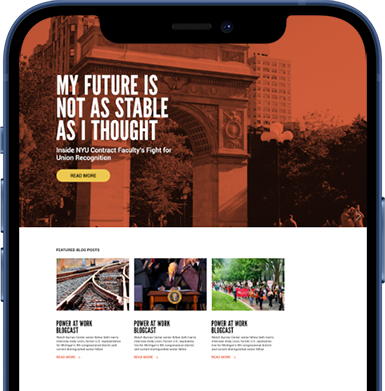Combining her life journey with lessons for communicators, Marrianne McMullen’s memoir Persuasive: 40 Lessons in Communicating for the Common Good traces her steps from a Catholic, working-class home in Pittsburgh to newspaper offices, union communications roles, and the White House. Drawing on real-world experiences and crises, Marrianne distills communications techniques that show how to craft effective messages grounded in human experience and shaped by pro-worker, pro-community values.
Her father operated a neighborhood gas station in the Steel City, while her Mom worked in retail and ran the home “like a project manager.” Helping at the gas station with her brothers, completing her mother’s chore list, and attending parochial school defined her early life, ensconced in a hard-working yet caring working-class community.
Marrianne’s background shaped her perspective as she ventured into journalism and studied at West Virginia University. She wrote about coal and found her way to the Akwesasne Native American reservation in Upstate New York, where she immersed herself in the community and its challenges. She covered a peace delegation to the Soviet Union and carefully slipped away from her handlers to meet and learn from the dissident community.
Along the way, she worked briefly at a New York City magazine and started a weekly newspaper in Dayton, Ohio. She eventually came to work in senior communications and public engagement roles with the American Federation of State, County, and Municipal Employees (AFSCME) Council 31 in Chicago, the Service Employees International Union (SEIU) in Illinois and Washington, D.C., and the D.C. public school system. During the Obama Administration, she served as a senior communicator with the Department of Health and Human Services. Currently, she manages communications for Chicago’s Chapin Hall, a research institute specializing in human services. Along the way, she and her husband, Jeff Epton, foster-parented six girls from a broken family and raised a son.
Working-class experience forms her worldview. When in Washington, D.C., she was surrounded by Ivy League strivers from privileged backgrounds. There were no West Virginia University graduates in that world. On occasion, her background caused her to hesitate, unsure how far to push. Soon, she realized her unique perspective brought depth others lacked. Her passion for education, learned from her own mothering experiences, sparked activism for better-performing schools and led to her current position, where she shares educational and human service research.
Based on Marianne’s experience in union communications and other social change roles, she created the “Persuasion Matrix” — a practical framework for mapping out goals, audiences, motivations, messages, messengers, and media to guide effective communication strategies.
The Matrix begins with identifying the desired action. Is it moving union members to vote, engage in a job action, or protest? Who can do it – members, officers, or community allies? Why would they do it or not do it? This means listening and understanding their interests and motivations. What messages resound? A member’s motivation might differ from a community ally’s motivation. Union officers or communicators should not be the only ones deciding the most effective message – that should come from the people whose involvement is desired. Finally, who are the best messengers, and how does one reach the intended audience? Perhaps the best messengers are union officials, impacted members, or community allies who feel the direct effects. And what media best reaches the intended audience? Are newspapers, television, radio, or electronic communication the best medium to convey the message? Using the matrix, one can then measure the results of the campaign’s effectiveness.
Marrianne applied these lessons when helping mobilize voters during Barack Obama’s 2008 Presidential campaign. SEIU sponsored a bus campaign to reach voters in Iowa, Missouri, Wisconsin, and Minnesota. A huge Labor Day concert in Minneapolis launched the effort with performances by Billy Bragg, Tom Morello, Steve Earle, and Allison Moorer. Younger staff members lobbied for hip-hop. Marrianne stood up for them, so Mos Def and the Pharcyde (a combined hip-hop artists’ ensemble) joined the stage. Younger voters saw their music on the stage. The bus tour captured media attention. Rank-and-file members spoke directly about why voting was important. The bus rally sparked door-to-door campaigning by local activists.
Did this mobilization help Obama win these key battleground states? The candidate won Iowa, Wisconsin, and Minnesota by 10 percentage points, and lost Missouri by only 4,000 votes. The greatest challenge in elections is mobilizing the occasional voter. This campaign exemplifies building media excitement, combined with grass-roots efforts, to excite voters. A well-crafted message helped Obama win these critical states.
The chapters are short, enticing, and readable. Each chapter ends with a pithy two-to-three-line lesson on effective communication, including short quotes that any communicator could tack to their wall. She ends chapter three, which recounts her experiences with the Akwesasne reservation, with: “Listen to those who challenge you, and go to places where you are not comfortable. That is where you will learn the most.” An apt message for these times ends chapter ten: “Lies can gather incredible momentum. If you know the truth, speak it.”
She addresses AI in a thoughtful manner and also the current proliferation of media platforms. She also lays the foundations for an effective communication team by identifying necessary skills and empowering staff, and helping them to feel supported.
This is an intriguing read for any labor or human service communicator. At its core is Marianne’s Persuasion Matrix – not a shortcut, but a disciplined approach that demands listening, hard work, and clarity of purpose. By weaving this framework into her life story, she demonstrates how authentic communication can build worker power, amplify community voices, and sustain collective action. By forthrightly sharing her own life experiences, a fascinating story is shared, rooted in human struggles, as the reader shares the lessons she learned and lived directly.
Persuasive: 40 Lessons in Communicating for the Common Good is available through Georgetown University Press.

